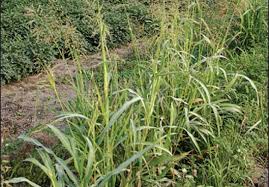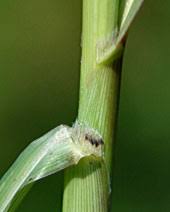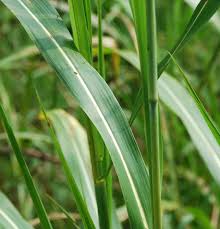 Johnsongrass
Johnsongrass
Family: Grass, Poaceae.
Habitat: Rich soils, cultivated fields throughout Ohio.
Life cycle: Perennial, spreading by rhizomes and seed.
Growth Habit: 3-6 feet or more.
Leaves: 0.5 -1 inch wide, smooth blades with a prominent white midvein.
Flower: July – October. Can be up to 1 foot or more in length; panicles are loosely branched, purplish, and hairy. spikelets occur in pairs or threes.
Roots: Fibrous. Rhizomes are found close to the soil surface. They are stout with purple spots and scales at the nodes.
Stem: Smooth, pink to rusty red near the base.
Similar plants: Look for rhizomes to distinguish johnsongrass from shattercane (Senecio bicolor).
The problem is…. Johnsongrass is very competitive with crops, spreading rapidly by rhizomes. It was initially introduced to the US as a forage crop, but its aggressive growing habit quickly made it undesirable. It is listed as a noxious weed in numerous states.
Currently there are 21 weeds on the Ohio Prohibited Noxious Weed List:
- Shattercane (Sorghum bicolor) – February 8
- Russian thistle (Salsola Kali var. tenuifolia) – February 22
- Johnsongrass (Sorghum halepense L. (Pers.)) May 24
- Wild parsnip (Pastinaca sativa) – May 21
- Wild carrot (Queen Anne’s lace) (Daucus carota L.)
- Oxeye daisy (Chrysanthermum leucanthemum var. pinnatifidum) – May 3
- Wild mustard (Brassica kaber var. pinnatifida)
- Grapevines: when growing in groups of one hundred or more and not pruned, sprayed,cultivated, or otherwise maintained for two consecutive years. – February 15
- Canada thistle (Cirsium arvense L. (Scop.)) – March 29
- Poison hemlock (Conium maculatum)
- Cressleaf groundsel (Senecio glabellus)
- Musk thistle (Carduus nutans) – March 26
- Purple loosestrife (Lythrum salicaria) – April 17
- Mile-A-Minute Weed (Polygonum perfoliatum) – March 7
- Giant Hogweed (Heracleum mantegazzianum) – March 14
- Apple of Peru (Nicandra physalodes) – February 28
- Marestail (Conyza canadensis)
- Kochia (Bassia scoparia) – May 1
- Palmer amaranth (Amaranthus palmeri)
- Kudzu (Pueraria montana var. lobata) – April 11
- Japanese Knotweed (Polygonum cuspidatum) – April 2
Each week, for the next 21 weeks, I will post information and pictures on how to identify these invasive and harmful plants.




